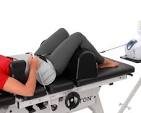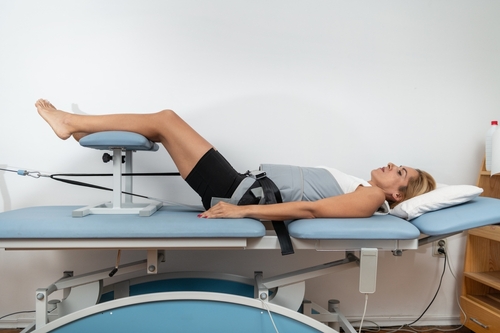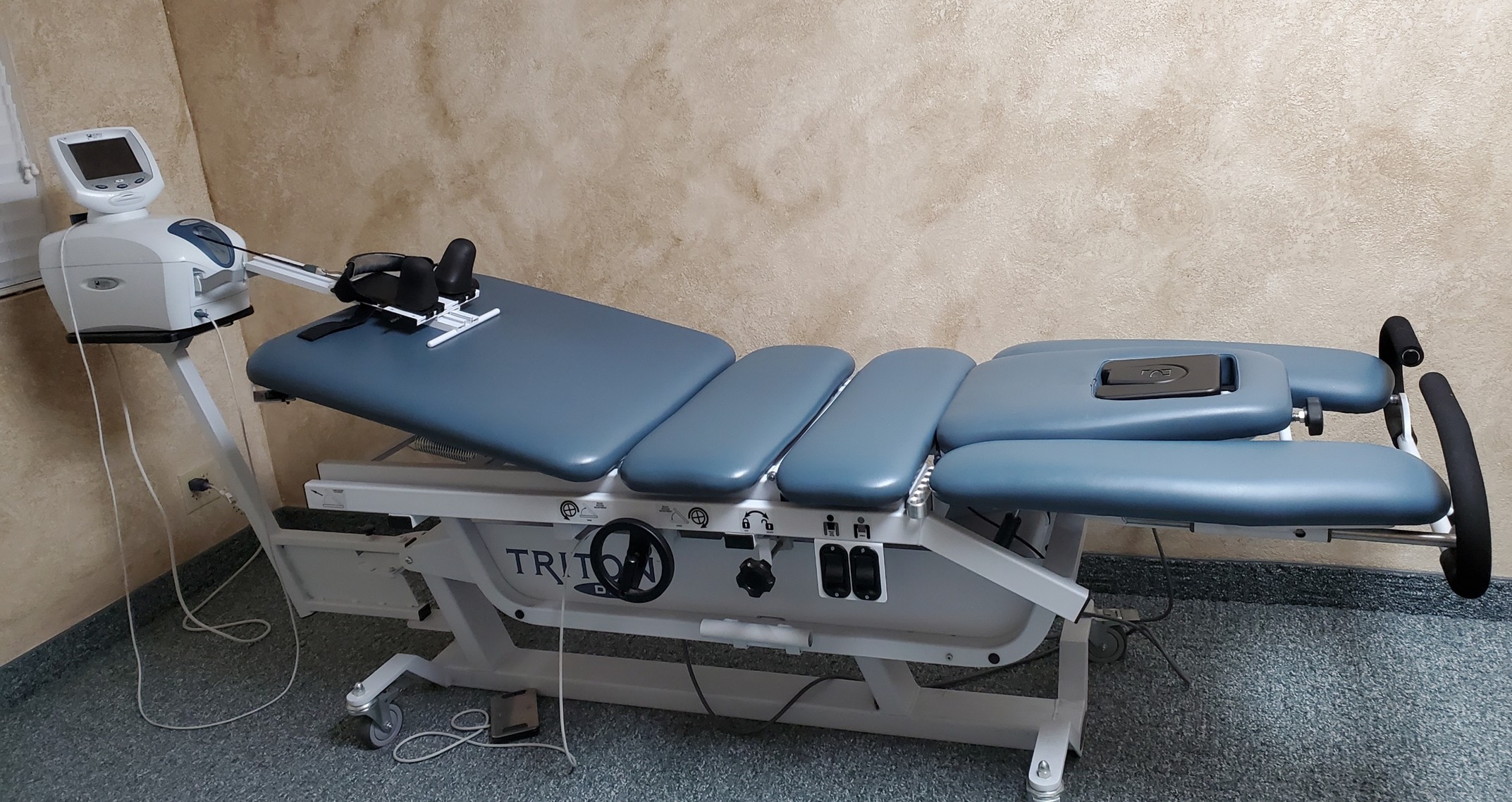For patients who have not found relief through chiropractic adjustments alone, many doctors and chiropractors recommend trying Spinal Decompression or Spinal Traction. There is often a general misunderstanding, even by many physicians, about the differences between these two therapies.
Both are used for the rehabilitation of neck and low back spinal disc conditions, such as bulging or herniated discs, degenerative disc disease, stenosis, sciatica, headaches, and migraines.
For both therapies, patients lie down on a table and are strapped with a belt around the hip area for low back conditions or around the head at the forehead for neck conditions. A pulling force is applied via a cable or line attached to the belt.
However, the specific use and effectiveness of these techniques varies considerably.

What is Spinal Decompression?
Spinal decompression is dynamic. It gently and gradually applies specific force to gently pull vertebrae apart until it achieves the maximum force. This maximum force in pounds of pressure is set by the doctor according to the patient’s size, condition, and level of comfort. The force is held for a small period of time and then gradually released to a lower resting amount. Then the cycle repeats itself. Spinal disc bulges and herniations are sucked back into the disc, alleviating pressure on the spinal nerves. The system cycles repeatedly to pump blood, fluid, and nutrients into the spinal disc.
It is this action that gives Spinal Decompression its unique ability to restore spinal discs. The patterns of distraction and relaxation strengthen the ligament bands, so they can hold the disc back in place again, speed healing, and make healing more permanent. Most patients with disc problems experience lasting relief by including Spinal Decompression in their treatment program.

What is Spinal Traction?
Spinal Traction applies a force to relieve pressure on the spinal discs by pulling the vertebrae apart and holding them in that position until the body’s muscles finally release. This method generally utilizes a greater force than Spinal Decompression to overcome the body’s muscular resistance. Because of this greater force, Spinal Traction can often cause the patient to experience muscle spasms as the body resists the force applied until the muscles are exhausted.
There are two main types of Spinal Traction.
The first is static. This means that the pressure is constant. It pulls the vertebrae apart and holds them in that position. Because it does not utilize distraction and relaxation cycles, it does not pump fluids into the spinal discs.
The second is dynamic, but utilizes greater force, not the gentle, subtle force applied by Spinal Decompression. This type of traction pumps blood and nutrients into the disc, but only after the muscles in the body finally let go and allow the pumping action.
Which Therapy is More Effective?
Although traction may be effective for mild back pain and in relieving muscle spasms, spinal decompression is the clear choice for spinal disc conditions. Research has shown that Spinal Traction is not as effective as Spinal Decompression in rehabilitating a spinal disc condition or injury.
A 2021 systematic review found that traction provided only short-term relief.1
A 1997 clinical trial comparing intermittent motorized traction to spinal decompression stated that “86% of ruptured disc patients had ‘good or excellent’ results using spinal decompression therapy” compared to only 55% of those who used motorized spinal traction.2
A 1998 study found that with the use of spinal decompression therapy “Pain, activity and mobility scores greatly improved for 71%of the 778 patients studied.3
A 2005 study of spinal decompression patients reported that “spinal decompression treatment leads to satisfactory pain relief and improved quality of life in up to 88% of patients, many of whom had failed other ‘conventional’ approaches and that the effect continues beyond the treatment cycle.”4
So while spinal traction provides only short-term relief, spinal decompression can provide true recovery with long term results.
A true decompression table allows the doctor to precisely treat specific spinal discs, while traction often just stretches the whole spine. The best spinal decompression systems can take constant measurements of the forces being exerted and adjust the force in real-time to avoid using too much pulling force. Spinal Traction cannot monitor the force in this manner.
Spinal Decompression has the ability to separate specific discs gradually and gently prevents the painful muscle spasms often experienced during spinal traction.
With Spinal Decompression, most of the treatment time is spent pumping fluid and nutrients into the disc area; whereas, with Spinal Traction, most of the time is wasted on the body’s resistance to being stretched.
Why do Some Doctors Still Use or Recommend Spinal Traction if Spinal Decompression is Superior?
Before the advent of Spinal Decompression, Spinal Traction was the best therapy available for treating spinal discs. Many doctors are not educated in the difference between these two therapies, and some companies’ advertisements claim their traction equipment can perform decompression. This has encouraged some doctors to purchase the less expensive traction equipment.
Are All Spinal Decompression Systems Alike?
No, not all Spinal Decompression Systems are equal. The best systems apply force in a very controlled way in each portion of the decompression cycles. These are computerized systems that allow for great personalization for each individual patient. They cost thousands of dollars but have been shown by research to be extremely effective.
There are many less expensive Spinal Decompression Tables with poor motion and ineffective function. They do not usually allow for as much specific personalization and, because of their poor design, are not capable of controlled, consistent pumping action to achieve results. Therefore, these tables are much less effective and often make little or no change in the patient’s condition.
There are also tables that are called “spinal decompression tables” that are actually only intersegmental roller tables. These tables have value in their function of relaxing muscles and helping increase motion in the curves of the spine, but do not truly accomplish any effective decompression.

Why Should I Come to Nixa Chiropractor Plus for Spinal Decompression?
At Nixa Chiropractor Plus, we use an advanced spinal Decompression Table, the Chattanooga Table with the Triton DTS computerized decompression unit.
The Triton DTS unit features a preprogrammed pattern, limiting decompression to the disc level the patient needs. Dr. Greenwood DC ND can set a specific amount of pressure within the bounds that has been clinically proven to safely reduce pressure on the disc so that his patients may enjoy relief and healing.
As a Naturopathic Physician (ND) as well as a Chiropractor, Dr. Greenwood will examine you first and may suggest Chiropractic Adjustments, Naturopathic Stretching, Exercise, Herbal Supplements, and Nutrition to help support your healing process.
At Nixa Chiropractor Plus, you will be treated like family. Our goal is for each of our patients to experience relief and healing so that they may enjoy optimum health and return to the activities they enjoy most without pain!
If you are looking for a chiropractor near me to find out if Spinal Decompression would be right for you, call Dr. Greenwood today at 417-725-6655 or stop by Nixa Chiropractor Plus at 1361 W. Mount Vernon St in Nixa, MO.
Isn’t it time you felt good again?
1. Vanti C, Turone L, Panizzolo A, Guccione AA, Bertozzi L, Pillastrini P. Vertical traction for lumbar radiculopathy: a systematic review. Arch Physiother. 2021 Mar 15;11(1):7. doi: 10.1186/s40945-021-00102-5. PMID: 33715638; PMCID: PMC7958699.
2. Shealy, C. Norman, and Vera Borgmeyer. “DECOMPRESSION, REDUCTION, AND STABILIZATION OF THE LUMBAR SPINE: A COST-EFFECTIVE TREATMENT FOR LUMBOSACRAL PAIN .” American Journal of Pain Management, vol. 7, no. 2, Apr. 1997.
3. Gose, E., et al. “Vertebral Axial Decompression for Pain Association with Herniated or Degenerated Discs or Facet Syndrome .” The Journal of Neurological Research , vol. 20, no. 3, 1998.
4. Technology Review: IDD Therapy, April 2005. Vol. 5, Issue 3. C. Norman Shealy, MD, Ph.D.



